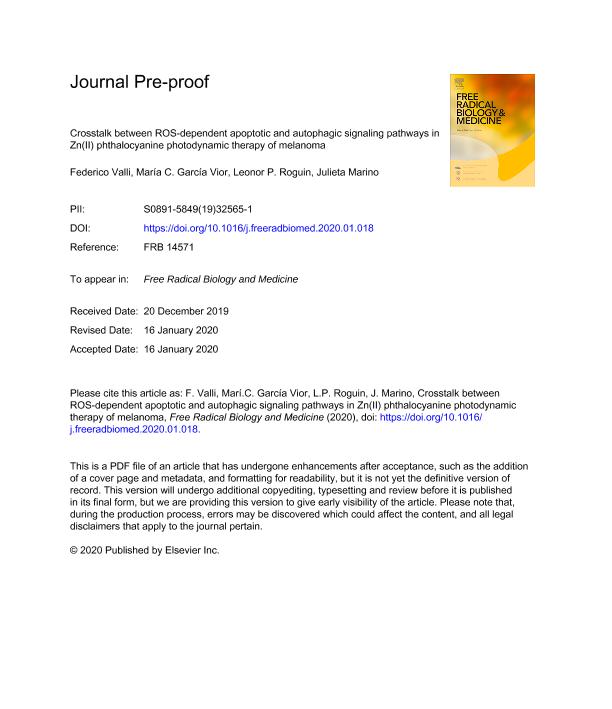Artículo
Crosstalk between ROS-dependent apoptotic and autophagic signaling pathways in Zn(II) phthalocyanine photodynamic therapy of melanoma
Fecha de publicación:
01/01/2020
Editorial:
Elsevier Science Inc
Revista:
Free Radical Biology and Medicine
ISSN:
0891-5849
Idioma:
Inglés
Tipo de recurso:
Artículo publicado
Clasificación temática:
Resumen
Melanoma is the most aggressive type of skin cancer, highly resistant to conventional therapies. Photodynamic therapy (PDT) is a minimally invasive treatment modality that combines the use of a photosensitizer, visible light and molecular oxygen, leading to ROS generation in the specific site of irradiation. The cationic zinc(II) phthalocyanine Pc13 has shown to be a potent photosensitizer in different melanoma cell lines. In this study, we explored the intracellular signaling pathways triggered by Pc13 PDT and the role of these cascades in the phototoxic action of Pc13 in human melanoma A375 cells. ROS-dependent activation of MAPKs p38, ERK, JNK and PI3K-I/AKT was observed after treatment. Inhibition of p38 reduced Pc13 phototoxicity, whereas blockage of ERK did not affect this response. Conversely, JNK inhibition potentiated the effect of Pc13 PDT. Results obtained indicate that p38 is involved in the cleavage of PARP-1, an important mediator of apoptosis. On the other hand, Pc13 irradiation induced the activation of an autophagic program, as evidenced by enhanced levels of Beclin-1, LC3-II and GFP-LC3 punctate staining. We also demonstrated that this autophagic response is promoted by JNK and negatively regulated by PI3K-I/AKT pathway. The blockage of autophagy increased Pc13 phototoxicity and enhanced PARP-1 cleavage, revealing a protective role of this mechanism, which tends to prevent apoptotic cell death.Furthermore, reduced susceptibility to treatment and increased activation of autophagy were detected in A375 cells submitted to repeated cycles of Pc13 PDT, indicating that autophagy could represent a mechanism of resistance to PDT. The efficacy of Pc13 PDT and an improved phototoxic action in combination with chloroquine were also demonstrated in tumor spheroids. In conclusion, we showed the interplay between apoptotic and autophagic signaling pathways triggered by Pc13 PDT-induced oxidative stress. Thus, autophagy modulation represents a promising therapeutic strategy to potentiate the efficacy of PDT in melanoma.
Palabras clave:
CELL SIGNALING
,
AUTOPHAGY
,
APOPTOSIS
,
PHOTODYNAMIC THERAPY
,
MELANOMA
Archivos asociados
Licencia
Identificadores
Colecciones
Articulos(OCA HOUSSAY)
Articulos de OFICINA DE COORDINACION ADMINISTRATIVA HOUSSAY
Articulos de OFICINA DE COORDINACION ADMINISTRATIVA HOUSSAY
Citación
Valli, Federico; Garcia Vior, María Cecilia; Roguin, Leonor Patricia; Marino, Veronica Julieta; Crosstalk between ROS-dependent apoptotic and autophagic signaling pathways in Zn(II) phthalocyanine photodynamic therapy of melanoma; Elsevier Science Inc; Free Radical Biology and Medicine; 1-1-2020
Compartir
Altmétricas




